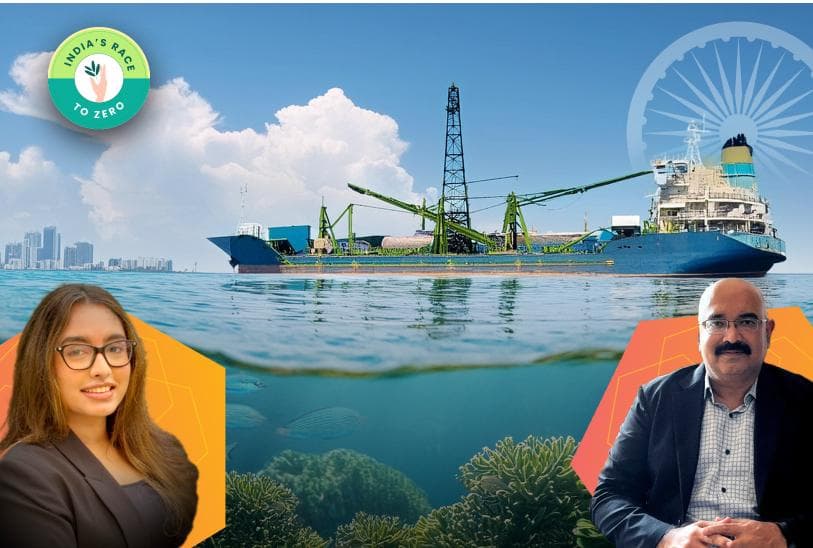Blue Carbon Leader: Will India Rise to Be Crowned?
Harnessing the Arabian Sea, Bay of Bengal, and Indian Ocean for sustainable growth and climate resilience to unleash India's Blue Carbon potential.
Isha Chakravarthy

The effects of climate change are undeniable. With record high temperatures, sandstorms, and an entire season dedicated to smog in New Delhi, it is clear that the dystopian futures we once imagined are now a reality. In response, the Supreme Court of India made a landmark decision, recognizing the right to a clean environment under Article 21 of the Constitution (the fundamental right to life and personal liberty) and Article 14 (the fundamental right to equality). This historic judgement has formulated a new constitutional right to be free from the adverse effects of climate change.
Inspired by this paradigm shift, Tinge of Green, in collaboration with Light of Asia, has commissioned a panel of ESG experts to engage in thought leadership advisory services and climate outreach. This article is one of the many products of this essential undertaking, aiming to position India as a leader in climate change control.
The Role of Blue Carbon
Conservation and reforestation are essential components of any effective climate policy. National parks, free from human intervention, have emerged as prominent carbon sequestration zones. However, another critical player in the fight against climate change is often overlooked: coral reefs.
The ocean sequesters 60 times more carbon than our atmosphere and absorbs nearly one-third of carbon emissions. According to IPCC estimates, the ocean accounts for nearly $3 trillion worth of emission reduction. Ocean habitats supported by corals, seagrass, and mangroves can sequester 4 to 20 times more carbon dioxide than terrestrial forests. These complex ecosystems, especially coral reefs, are among the most economically and socially valuable commodities on our planet.
India's Coastal Challenge
Nearly 20% of the Earth’s surface is coastal land, inhabited by 40% of the world’s population. Yet, only 6.4% of the ocean is classified as a ‘Marine Protected Area’ safeguarded for long-term conservation efforts. Since 1957, the area covered by coral reefs has fallen by nearly 50%. This highlights the urgent need to protect these areas from climate change.
India's coastal region spans over 7,500 kilometres, with nearly 250 million people living within 50 kilometres of the coast. This places 3% of the world’s population at significant risk from climate change. These regions have seen a sea-level rise of 8.5 centimetres in the last 50 years, and it is expected that 36 million Indians will live in chronically flooded zones by 2100. States like Andhra Pradesh, Maharashtra, and Odisha are particularly vulnerable due to their heavy reliance on marine life and fishing for income.
The Blue Economy: A Path Forward
The health and safety of India's marine ecosystems are crucial to its marine economy. This has led to the rise of the 'Blue Economy,' an ideology centered on promoting sustainable marine economic development. The Blue Economy supports transport, offshore energy production, aquaculture, and marine biotechnology, with sustainability as a primary driving force.
India's draft policy for the Blue Economy was released in 2021, aiming to enhance economic contributions and improve livelihoods. The Maritime India Vision 2030 (MIV 2030) was introduced to bolster a sustainable maritime industry, featuring 150 initiatives aimed at creating safe and sustainable ports. However, projects like the Mumbai Coastal Road have negatively impacted local communities, reducing the average income of fisherfolk by 50%.
With 199 existing ports and six mega-ports planned by 2047, India currently services 95% of its trade through sea (1,400 million tons), contributing 4-5% to its GDP. India is also the second-largest fish producer in the world, providing income for 25 million fishers and fish farmers, and nearly 50 million people engaged along the value chain. While infrastructure development is necessary, it must be balanced with sustainable practices to protect impoverished communities.
The Economic Potential of Blue Carbon
India's private and public policies on marine conservation, reef preservation, and carbon sequestration have been more reactive than proactive. This approach prioritizes development with little regard for the cost. Programs like the Marine Spatial Planning framework launched in Puducherry in 2023 aim to reduce conflicts and safeguard local interests. While a step in the right direction, more proactive measures are needed.
India currently has a pipeline of 44 port projects worth INR 30,000 crore. The financial benefits of sustainable development are clear. Blue carbon sequestration, or marine carbon sequestration, is 10 to 20 times more cost-efficient than terrestrial forests. Despite India's depleted marine ecosystems, which cover only 0.5% of the country's total area, there is a $28 billion opportunity from carbon offsetting, with an additional $8 billion if existing ecosystems are conserved and protected. Reefs, seagrass, and mangrove forests also provide the benefit of protecting residents from natural disasters by breaking their momentum.
Increasing the area covered by marine ecosystems to 3% would create an additional revenue opportunity of nearly $180 billion. These calculations do not account for the additional revenue generated through eco-tourism, empowering local economies, disaster prevention, and more.
A Call to Action
The market gap for innovations in this space is significant from both an economic and impact standpoint. The need of the hour is a proactive sustainability framework around marine infrastructure that permanently links the economic interests of public and private players with the ESG outcomes of their developments. Without spearheading change, there will be no one to save us from the deluge when the glass tank finally shatters.
Stay tuned for the next article in this series
To learn more about the Blue Carbon opportunity contact shashi@tingeofgreen.com
